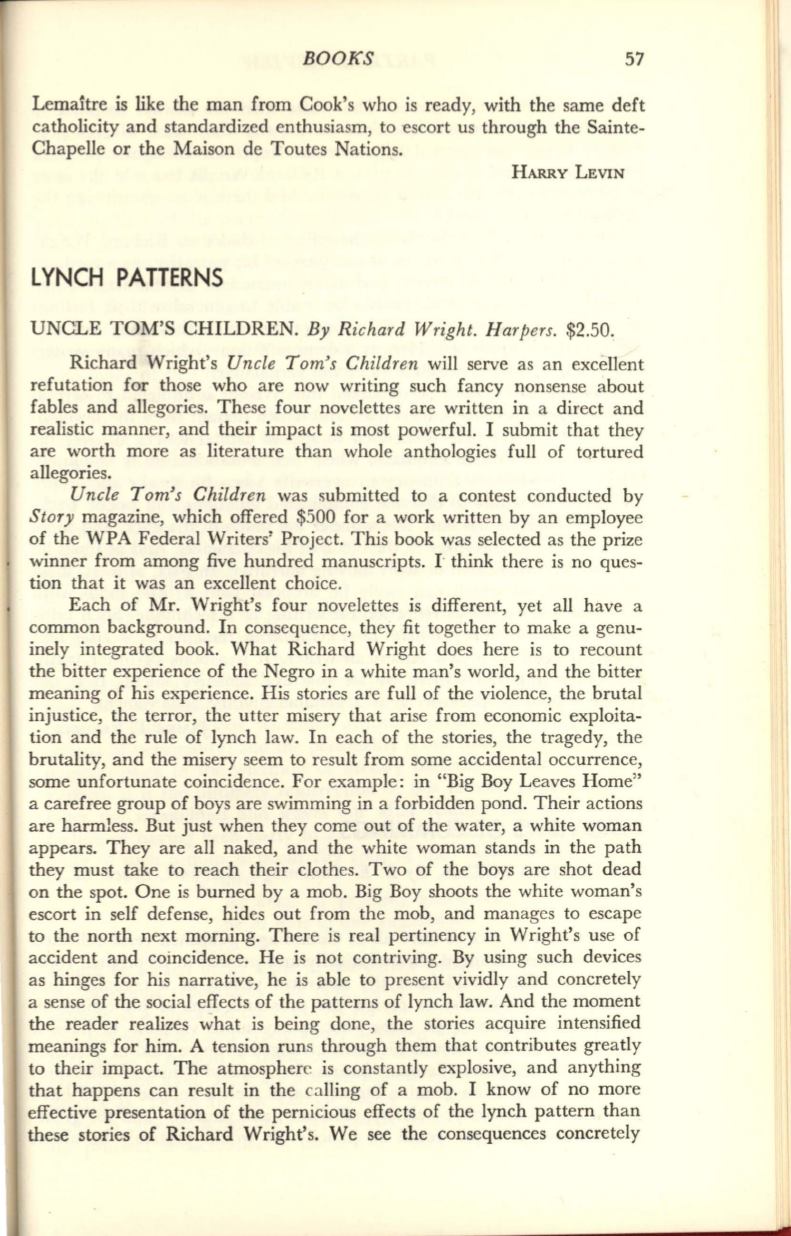
BOOKS
57
Lemaitre is like the man from Cook's who is ready, with the same deft
catholicity and standardized enthusiasm, to 'escort us through the Sainte–
Chapelle or the Maison de Toutes Nations.
HARRY LEVIN
LYNCH PATTERNS
UNCLE TOM'S CHILDREN.
By
Richard Wright. Harpers.
$2.50.
Richard Wright's
Uncle Tom's Children
will serve as an excellent
refutation for those who are now writing such fancy nonsense about
fables and allegories. These four novelettes are written in a direct and
realistic manner, and their impact is most powerful. I submit that they
are worth more as literature than whole anthologies full of tortured
allegories.
Uncle Tom's Children
was submitted to a contest conducted by
Story
magazine, which offered $500 for a work written by an employee
of the WPA Federal Writers' Project. This book was selected as the prize
winner from among five hundred manuscripts. 1 think there is no ques–
tion that it was an excellent choice.
Each of Mr. Wright's four novelettes is different, yet all have a
common background. In consequence, they fit together to make a genu–
inely integrated book. What Richard Wright does here is to recount
the bitter experience of the Negro in a white man's world, and the bitter
meaning of his experience. His stories are full of the violence, the brutal
injustice, the terror, the utter misery that arise from economic exploita–
tion and the rule of lynch law. In each of the stories, the tragedy, the
brutality, and the misery seem to result from some accidental occurrence,
some unfortunate coincidence. For example: in "Big Boy Leaves Home"
a carefree group of boys are swimming in a forbidden pond. Their actions
are harmless. But just when they come out of the water, a white woman
appears. They are all naked, and the white woman stands in the path
they must take to reach their clothes. Two of the boys are shot dead
on the spot. One is burned by a mob. Big Boy shoots the white woman's
escort in self defense, hides out from the mob, and manages to escape
to the north next morning. There is real pertinency in Wright's use of
accident and coincidence. He is not contriving. By using such devices
as hinges for his narrative, he is able to present vividly and concretely
a sense of the social effects of the patterns of lynch law. And the moment
the reader realizes what is being done, the stories acquire intensified
meanings for him. A tension runs through them that contributes greatly
to their impact. The atmosphere is constantly explosive, and anything
that happens can result in the calling of a mob. I know of no more
effective presentation of the pernicious effects of the lynch pattern than
these stories of Richard Wright's. We see the consequences concretely


